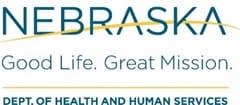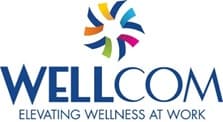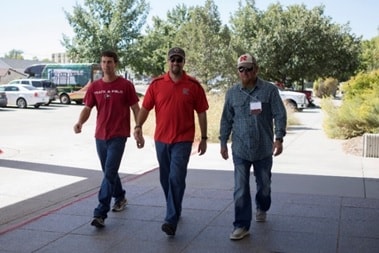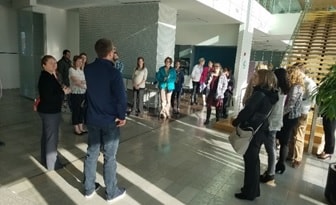Partnering With Wellness Councils: Nebraska Department Of Health And Human Services

Download Available pdf icon[PDF – 542 KB]

The Nebraska Department of Health and Human Services (NE DHHS) supports employee health by partnering with three local worksite wellness councils. The councils provide direct wellness initiative support and education to employers. The multiple levels of support in this model and the communication between NE DHHS and the councils make the most of reach, impact, and flexibility to meet employer needs.
- Year NE DHHS started worksite wellness programming: 1986
- Population of state: 1.92 million
- Workforce: 1.01 million (983,000 employed)
- Total reach by councils: 7% of the Nebraska’s employers
History Of The Councils

WELLCOM
Founded by four business leaders in Omaha, Wellness Council of the Midlands (now known as WELLCOM) was one of the first nonprofit worksite wellness council in the United States. WELLCOM serves the most-populated region in the state.
- Year Established: 1982
- Type: Private, nonprofit, standalone 501(c)(3) organization
- Location: Omaha and the surrounding metropolitan area; Western Iowa, including Des Moines and the surrounding metropolitan area
- Number of Employer Members: 110
- Number of Staff: 3 full time; 1 part time; 2 senior-level consultants
- Total reach (including employee families): 274,000
WorkWell

Lincoln-area business leaders and the local health department created WorkWell. It was the first public health department created worksite wellness council in the United States. WorkWell became a nonprofit organization in 2003, and in 2013 began merging with the Nebraska Safety Council. The joint council will have the largest number of employer members of any state-based worksite wellness council in the United States. WorkWell is an affiliate of the National Institute for Occupational Safety and Health and serves employers across Nebraska.
- Year established: 1986
- Type: Nonprofit 501(c)(3) organization; a division under the Nebraska Safety Council, also a nonprofit 501(c)(3) organization.
- Location: Lincoln and the surrounding metropolitan area; serves employers across Nebraska
- Number of employer members: 550
- Number of staff: 14 (2.5 FTE dedicated to wellness and 4 part time health coaches)
- Total reach (including employee families): 597,680
Panhandle Worksite Wellness Council
Panhandle Worksite Wellness Council (Panhandle), a division of the Public Health Accreditation Board (PHAB) Accredited Panhandle Public Health District, serves businesses in the rural Panhandle region of Western Nebraska. This council was formed to reach employers in the region farthest from the state capitol. Panhandle reaches numerous small employers in a rural region that covers 15,000 square miles.

- Year Established: 2011
- Type: Public under the umbrella of the Panhandle Public Health District.
- Location: Hemingford, serving the Panhandle region
- Number of employer members: 47
- Number of Staff: 1.5
- Total reach (including employee families): 26,400
History Of The Partnerships
In the 1980s, NE DHHS worked in schools to address childhood public health issues. With the formation of WorkWell, it saw a chance to partner with the councils to reach workplaces and address public health issues for adults. NE DHHS leveraged the councils’ relationships with employers to increase the reach of its health promotion efforts. According to Judy Martin, Deputy Director at NE DHHS, “It was a new avenue, and when you think about how much time people spend at their workplace, it really just made so much sense.”
These partnerships have evolved over time. In the beginning, NE DHHS was a bridge, fostering relationships between WELLCOM and WorkWell and developing the foundation for support and collaboration. As funding became available, NE DHHS was able to help the councils support employers in their worksite wellness initiatives. NE DHHS and the councils also have worked together to increase reach—the three councils collectively include seven percent of Nebraska employers as members.
NE DHHS And Councils’ Collaborative Approach To Worksite Wellness
The collaborative relationships between NE DHHS and the councils are based on their shared commitment to health promotion in the workplace. NE DHHS provides information on evidence-based approaches and national trends in workplace health promotion. The councils provide training and resources for employers to develop or expand worksite wellness initiatives. The councils also collect employer data through surveys, health risk assessments (in aggregate form), and feedback, and report on policy, systems and environmental (PSE) change project data.
We really appreciate the fact that it’s not just a one-sided relationship [between NE DHHS and the councils], but it’s very give and take, and we’re allowed that autonomy to be able to work on our own . . . There are also several opportunities where we can partner and collaborate [with the state and/or councils] and be a part of each other’s activities.
~ Theresa Nelson, WELLCOM
State And Council Relationships
NE DHHS meets every quarter with all three councils to discuss trends, funding opportunities, and potential resource development. Each council also meets monthly with NE DHHS to discuss priorities and provide updates with employers in their region. NE DHHS coordinates activities across the councils and provides subject matter expertise. For example, Brian Coyle, Physical Activity Coordinator at NE DHHS, oversees much of the worksite wellness efforts, such as funding allocation, resource development, and coordination with the councils. He also provides expertise on physical activity.
Each council collects data for its region and shares the information with NE DHHS. This allows the state to focus on the development of guides and toolkits and to provide subject matter expertise.
The state funds the councils to support resource development, events, and activities through the CDC Preventive Health and Health Services Block Grant (PHHS), as well as the CDC’s Division of Nutrition, Physical Activity, and Obesity 805, 1305, and 1422 grants. The councils can give money to employers as mini-grants. These mini-grants serve as seed money for specific program outcomes (PSE change projects) to get employers started on worksite wellness initiatives.
I like being the silent partner because, really, it’s about the councils, it’s about the local partnerships, it’s about the local relationships. We’re just lucky enough to be a part of the process. And I think that’s the most important piece . . . we can provide a little bit of funding to the worksite councils to enhance their relationships—to provide assistance, to provide training, to provide resources—so that the businesses have a direction they can head that is their direction.
~ Brian Coyle, NE DHHS
Council And Employer Relationships
The councils provide one-on-one support to employers through mini-grants, activities, resources, and consultation. They help employers build a comprehensive foundation of wellness and expand their wellness offerings. The councils also provide guidance on evidence-based practices and policies, and connect employers to experts on many topics. For example, Box Butte General Hospital meets with the Panhandle Worksite Wellness Council to discuss its hospital wellness plan and how to align it with the hospital’s community health improvement plan.
The resources that I’ve had because of that relationship [between NE DHHS and the councils] has allowed us to do so much more than if I was sitting here scratching my head on how I am going to impact an entire community and an entire region with a community health improvement plan, with no information on who else is doing this out there and how they’re approaching that. I also think that it allows us [Box Butte General Hospital and the Panhandle Worksite Wellness Council] to get together and talk about the strategies and determine what’s the best bang for our buck and how we’re going to do that across the board.
~ Dan Newhoff, Box Butte General Hospital,
Panhandle Worksite Wellness Council member
The councils provide employers with guides and toolkits developed through the NE DHHS-council partnership. These resources cover many workplace health strategies, such as campus walkability, healthy vending-machine foods, breastfeeding, and commuting. The resources also provide employers with guidance on policy changes using evidence-based best practices.
For sustainability for that sort of intensity with businesses, I think that local connection makes all the difference . . . and with that policy and environmental support model, those things don’t go away. So, leadership may change, but the policies stay in place . . . I can’t imagine at the state-level, them [NE DHHS] trying to reach out to businesses without this sort of structure.
~ Kim Engel, Panhandle Worksite Wellness Council
The councils offer training on evidence-based interventions. They provide onsite support in helping employers carry out interventions on active living, breastfeeding, healthy eating, diabetes and diabetes prevention, and other topics.
We’ve sat down around the round table and walked through our reports and the impact survey and talked about our overall risk scores and what we need to work on, where are we stressed, and what are the leading diseases in our organization—so what we should focus on. That’s very helpful to me because they’re really good at talking in a language that I can understand and that I can then relay to my folks.
~ Kay Sudbeck, Speedway Motors, WorkWell member
The councils also host other events to promote worksite wellness. All councils offer networking and recruiting events and recognition ceremonies for recipients of the Governor’s Award. The councils hold recruiting events and invite members to discuss the benefits of council membership with other employers.

Northwest Rural Public Power District employees walking at lunch during the Panhandle Safety & Wellness Conference & Awards Luncheon. Nebraska’s governor leads the walk when possible. The conference also offers standing tables to give attendees the option of standing during sessions.
NE DHHS and the councils recognize employers’ wellness efforts with the Governor’s Award of Excellence. They select awardees using the following evidence-based criteria:
- Leadership engagement
- Data collection
- An established wellness plan
- Policies and benefits options
- Community involvement
The award provides recognition to employers that implement evidence-based wellness programs. The data collected from applicants provides rich information to the councils and NE DHHS about employers’ wellness programs and helps identify gaps or needs.
For more information, visit the Governor’s Award websiteexternal icon
Benefits Of The State–Council Model
The partnership between NE DHHS and the worksite wellness councils has produced many benefits. This model has strengthened relationships between the state and councils, among the councils, and among employers. This approach has also helped the state more effectively gauge the needs of employers across the state. But perhaps the greatest benefit is that NE DHHS and the councils are able to work from a common vision of how to reach the people of Nebraska.
Creating Connections
The partnership helps keep NE DHHS in tune with the needs of employers. The councils are better able to connect with one another and develop resources together. They can also connect employer members to other councils, employers, and resources. Employers say their relationship with their local wellness council makes them feel connected to other regions and allows them to know what is going on in other parts of the state.

Participants receive a tour of Gallup’s offices in Omaha, Nebraska, as part of WELLCOM’s Traveling Coffee Club networking event. The Traveling Coffee Club gives WELLCOM members the opportunity to look behind the scenes at other member companies’ wellness programs, discuss common struggles, and learn from each other’s successes.
Addressing The Diverse Needs Of Employers Across The State
It takes over nine hours to travel from one side of the state to the other. And there is no way we would have the program we have now if we had to travel nine hours. You can’t learn if you can’t be face-to-face.
~Diana Lecher, Chadron Community Hospital, Panhandle Worksite Wellness member
NE DHHS’s relationships with the councils give them a more in-depth understanding of the diversity of employers across Nebraska—in industries, sizes, structures, and needs. Members of the Panhandle Worksite Wellness Council say they like having a voice through the councils, and thus they are more likely to engage in wellness initiatives.
Creating A Common Vision
Through their partnerships with NE DHHS, the councils are able to develop wellness initiatives in worksites across the state. The councils’ one-on-one relationships with employers has resulted in a unified approach to supporting them.
Challenges And Future Plans
An ongoing challenge for NE DHHS and the councils is the councils’ future. Funding is not guaranteed from year to year. Changes in focus for grants are likely over time. To lessen these potential effects, NE DHHS and the worksite councils are developing plans to ensure that the councils are self-sustaining.
To improve wellness council coverage across Nebraska, the state plans to reach out to public health departments in other regions to promote partnerships with the worksite wellness councils to further enhance worksite wellness initiatives across the state.
Advice For Other Health Departments
NE DHHS pointed out that for other state health departments, partnering with worksite wellness councils or other organizations on worksite health promotion is a great opportunity to influence the health of a large proportion of the adult population in a state. Judy Martin, NE DHHS Deputy Director, indicated that the benefits of this kind of partnership go beyond the potential reach that most health departments would be able to achieve on their own: “It is such a golden opportunity, that if state health departments haven’t engaged in worksite wellness efforts in a proactive fashion, the benefits are there.” Coyle and Martin also indicated that many employers relate more easily to the councils than they do to the health department.
Recommendations For Action
- Leverage your funding streams to help build partnerships in your state. Learn more about the PHHS Block Grant and the goals of Healthy People 2020external icon.
- Develop partnerships at the state, regional, and local level—such as between local health departments and councils—to help expand your reach to employers across your state. Integrating councils into local health districts will help maintain councils’ existence. Search CDC’s WHRC List of Organizations to identify potential partners.
- Consider different ways to address the needs of employers across your state, such as through resources, recognition, and events. Building data-collection capacity into these methods will help. For example, you could require employers to submit findings from health risk assessments and surveys in order to receive recognition and awards.
The CDC Workplace Health Resource Center (WHRC) is a one-stop shop for organizations to find credible tools, guides, case studies, and other resources to design, develop, implement, evaluate, and sustain workplace health promotion programs. Visit https://www.cdc.gov/WHRC to find more case studies of workplace health programs in the field.